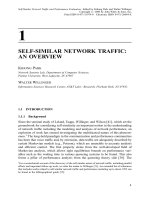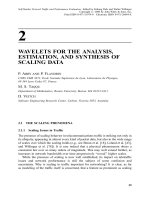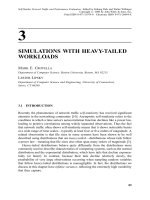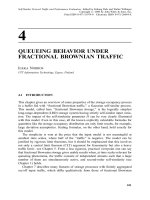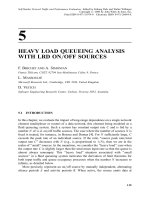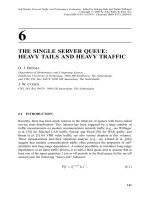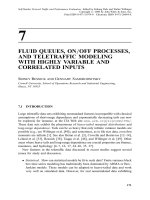Tài liệu Mạng lưới giao thông và đánh giá hiệu suất P10 doc
Bạn đang xem bản rút gọn của tài liệu. Xem và tải ngay bản đầy đủ của tài liệu tại đây (209.05 KB, 20 trang )
10
ASYMPTOTIC ANALYSIS OF QUEUES
WITH SUBEXPONENTIAL ARRIVAL
PROCESSES
P. R. J
ELENKOVIC
Â
Department of Electrical Engineering, Columbia University, New York, NY 10027
10.1 INTRODUCTION
One of the major challenges in designing modern communication networks is
providing quality of service to the individual users. An important part of this design
process is understanding statistical characteristics of networktraf®c streams and
their impact on networkperformance. Unlike the conventional voice traf®c, modern
data traf®c exhibits an increased level of ``burstiness'' that spans over multiple time
scales. It was observed that sample paths of these data sequences show evidence of
self-similarity. Their autocorrelation structure is characterized by long-range depen-
dency and the empirical distributions are easily matched with subexponential and
long-tailed distributions. Early discovery of the self-similar nature of Ethernet traf®c
was reported in Leland et al. [42] (see also Leland et al. [43]). More recently,
Crovella [22] attributed the long-range dependency of Ethernet traf®c to the long-
tailed ®le sizes that are transferred over the network. Long-range dependency of the
variable bit rate video traf®c was demonstrated by Beran et al. [9]. Long-tailed
characteristics of the scene length distribution of MPEG video streams were
explored in Heyman and Lakshman [30] and Jelenkovic et al. [37].
Practical importance, novelty, and the intriguing nature of these phenomena have
attracted a great number of scientists to develop new traf®c models and to under-
stand the impact of these models on networkperformance. In this development there
Self-Similar Network Traf®c and Performance Evaluation, Edited by Kihong Parkand Walter Willinger
ISBN 0-471-31974-0 Copyright # 2000 by John Wiley & Sons, Inc.
249
Self-Similar Network Traf®c and Performance Evaluation, Edited by Kihong Parkand Walter Willinger
Copyright # 2000 by John Wiley & Sons, Inc.
Print ISBN 0-471-31974-0 Electronic ISBN 0-471-20644-X
have been two basic approaches: self-similar (fractal) processes and ¯uid renewal
models with long-tailed renewal distributions. In this presentation we focus on the
latter. The investigation of queueing systems with self-similar arrival processes can
be found in the literature [23, 24, 44, 47, 49, 51, 54, 55].
In this chapter some recent results are presented on the subexponential asymptotic
behavior of queueing systems with subexponential arrival streams. The related
references will be listed throughout the chapter. First, in Section 10.2 the classes of
long-tailed and subexponential distributions are de®ned and some of their basic
properties are presented. Section 10.3 begins with a presentation of a classical result
on the subexponential asymptotics of a GI=GI=1 queue. That is followed by a brief
discussion of various extensions of this result that can be found in the literature. The
remainder of Section 10.3 contains two new results on this subject. In Section 10.3.1
a derivation is given for a straightforward asymptotic approximation for the loss rate
in a ®nite buffer GI =GI=1 queue. It appears surprising that the derived asymptotic
formula does not depend on the queue service process. However, a simple intuitive
explanation of this insensitivity effect is provided. In Section 10.3.2 a GI =GI =1
queue with truncated heavy-tailed arrival sequences is analyzed. Explicit asymptotic
characterization of a unique behavior of the queue length distribution is given.
Informally, this distribution on the log scale resembles a stair-wave function that has
steep drops at speci®c buffer sizes. This has important design implications,
suggesting that negligible increases of the buffer size in certain buffer regions can
decrease the over¯ow probabilities by orders of magnitude.
Section 10.4 describes a class of ¯uid queues and addresses the problem of
multiplexing on=off sources with heavy-tailed on periods. A complete rigorous
treatment of the subexponential asymptotic behavior of a ¯uid queue with a single
on=off arrival process is presented in Section 10.4.1. Section 10.4.2 investigates
multiplexing a heavy-tailed on=off process with a process that has a lighter
(exponential) tail. It is shown that this queueing system is asymptotically equivalent
to the queueing system in which the process with the lighter tail is replaced by its
mean value. This has implications on multiplexing bursty data and video traf®c with
relatively smooth voice sources. Section 10.4.3 addresses the problem of multi-
plexing on=off sources with heavy-tailed on periods. Understanding of this problem
is fundamental for achieving high networkresource utilization and providing quality
of service in the bursty traf®c environment. Under a speci®c stability condition this
problem admits an elegant asymptotic solution. A brief conclusion of the presenta-
tion is given in Section 10.5.
10.2 LONG-TAILED AND SUBEXPONENTIAL DISTRIBUTIONS
This section contains necessary de®nitions of long-tailed and subexponential
distributions. An extensive treatment of subexponential distributions (and further
references) can be found in Cline [17, 18] or in the recent survey by Goldie and
KluÈppelberg [27].
250
ASYMPTOTIC ANALYSIS OF QUEUES WITH SUBEXPONENTIAL ARRIVALS
De®nition 10.2.1. A distribution function F on 0; I is called long-tailed
F P l if
lim
x3I
1 À Fx À y
1 À Fx
1; y P R: 10:1
De®nition 10.2.2. A distribution function F on 0; I is called subexponential
F P s if
lim
x3I
1 À F
Ã2
x
1 À Fx
2; 10:2
where F
Ã2
denotes the second convolution of F with itself, that is, F
Ã2
x
0;I
Fx À yFdy.
The class of subexponential distributions was ®rst introduced by Chistakov [15].
The de®nition is motivated by the simpli®cation of the asymptotic analysis of
convolution tails. The best-known examples of distribution functions in s (and l)
are functions of regular variation r
Àa
(in particular, Pareto family); F P r
Àa
if it is
given by
Fx1 À
lx
x
a
; a ! 0;
where lx : R
3 R
is a function of slow variation, that is, lim
x3I
ldx=lx
1; d > 1. These functions were invented by Karamata [38] (the main reference book
is by Bingham et al. [10]). The other examples include lognormal and some Weibull
distributions (see Jelenkovic and Lazar [36] and KluÈppelberg [40]).
A few classical results from the literature on subexponential distributions follow.
The general relation between s and l is presented in Lemma 10.2.3.
Lemma 10.2.3 [7]. s & l.
Lemma 10.2.4. If F P l then 1 À Fxe
ax
3Ias x 3I, for all a > 0.
N
OTE
10.2.5. Lemma 10.2.4 clearly shows that for long-tailed distributions
Crame
Â
r-type conditions are not satis®ed.
One of the most basic properties of subexponential distributions is given in the
following lemma. It roughly states that the sum of n i.i.d. random variables exceeds a
large value x due to one of them exceeding x.
Lemma 10.2.6. Let fX
n
; n ! 1g be a sequence of i.i.d. random variables with a
common distribution F and let S
n
P
n
i1
X
i
. If F P s, then
PS
n
> x$nPX
1
> x as x 3I: 10:3
10.2 LONG-TAILED AND SUBEXPONENTIAL DISTRIBUTIONS
251
Often in renewal theory it is of interest to investigate the integrated tail of a
distribution function. To simplify the notation, for any distribution F we denote by
Fx1 À Fx,
^
Fx
def
I
x
Ft dt, and F
1
x
def
m
À1
m À
^
Fx, where m
^
F0.
Throughout the text F
1
x will be referred as the integrated tail distribution of Fx.
De®nition 10.2.7. F P s*if
x
0
Fx À y
Fx
Fy dy 3 2m
F
< I; as x 3I;
where m
F
I
0
yFdy.
This class of distributions has the property that F P s* A F
1
P s, and that
s* & s. Suf®cient conditions for F P s* can be found in KluÈppelberg [41],
where it was explicitly shown that lognormal, Pareto, and certain Weibull distribu-
tions are in s*.
10.3 LINDLEY'S RECURSION AND GI=GI =1 QUEUE
Let fA; A
n
; n P N
0
g and fC; C
n
; n P N
0
g be two independent sequences of i.i.d.
random variables (on a probability space (O; f; P)). We term A
n
and C
n
as the
arrival and service process, respectively. Then, for any initial random variable Q
0
,
the following Lindley's equation,
Q
n1
Q
n
A
n1
À C
n1
; 10:4
de®nes the discrete-time queue length process fQ
n
; n ! 0g. According to the
classical result by Loynes [45] (see also Baccelli and Bremaud [8, Chap. 2]),
there exists a unique stationary solution to recursion (10.4), and for all initial
conditions the queue length process converges (in ®nite time) to this stationary
process. In this chapter it is assumed that the queue is in its stationary regime, that is,
fQ
n
; n ! 0g is the stationary solution to recursion (10.4).
Recursion (10.4) also represents the waiting time process of the GI =GI =1 queue
with C
n
being interpreted as the interarrival time between the customer n À 1 and n,
A
n
as the customer's n service requirement, and Q
n
as the customer's n waiting time.
For that reason the terms waiting time distribution for the GI=GI =1 queue and the
queue length distribution for the discrete time queue will be used interchangeably.
Some of the ®rst applications of long-tailed distributions in queueing theory were
done by Cohen [20] and Borovkov [11] for the functions of regular variations.
Cohen derived the asymptotic behavior of the waiting time distribution for the
M=GI =1 queue. This result was extended by Pakes [48] to GI =GI =1 queue and the
whole class of subexponential distributions. In Veraverbeke [56] the same result
was rederived using a random walktechnique. Let G and G
1
represent the
252
ASYMPTOTIC ANALYSIS OF QUEUES WITH SUBEXPONENTIAL ARRIVALS
distribution and its integrated tail distribution for A
n
, respectively, G
1
x
x
0
PA > u du=EA.
Theorem 10.3.1 (Pakes). If G
1
P s (or G P s*), and EA
n
< EC
n
, then
PQ
n
> x$
1
EC
n
À EA
n
I
x
PA
n
> u du as x 3I:
There are several natural avenues for extending this result. In Willekens and
Teugels [58] and Abate et al. [1] asymptotic expansion re®nements to Theorem
10.3.1 were investigated. For extensions of Theorem 10.3.1 to Markov-modulated
M=G=1 queues see Asmussen et al. [4], and to Markov-modulated G=G=1 queues
(equivalently random walks) see Jelenkovic and Lazar [36]. Further extension of
these results to more general arrival processes was obtained in Asmussen et al. [6].
Recently, Asmussen et al. [5] established an asymptotic relationship between the
number of customers in a GI =GI=1 queue and their waiting time distribution.
In the rest of this section recent results are presented on a GI =GI =1 queue with a
®nite buffer and truncated heavy-tailed arrival sequences.
10.3.1 FiniteBuffer GI=GI=1 Queue
In engineering networkswitches it is very common to design them as loss systems.
The main performance measures for these systems are loss probabilities and loss
rates. Unfortunately, there are no asymptotic results in literature that address this
problem under the assumption of long-tailed arrivals. Recently, I investigated this
problem [31, 33].
Here, in Theorem 10.3.2, I present the main result from my earlier work[31]. The
theorem gives an explicit asymptotic characterization of the loss rate in a ®nite buffer
queue with long-tailed arrivals. This result, in combination with results from
Jelenkovic and Lazar [35], yields a straightforward asymptotic formula for the
loss rate in a ¯uid queue with long-tailed M=G=I arrivals (for more details see
Jelenkovic [31, 33]). In addition, I [31, 33] derived an explicit asymptotic
approximation of buffer occupancy probabilities. This approximation is uniformly
accurate for buffer sizes that are away from the buffer boundaries (zero and the
maximum buffer size). Furthermore, as the maximum buffer size increases, the
length of the buffer around the boundaries where the approximation does not apply
stays constant. This precise knowledge of the buffer probabilities allows computa-
tion of various other functionals of the ®nite buffer queue.
The evolution of a ®nite buffer queue is de®ned with the following recursion:
Q
B
n1
minQ
B
n
A
n1
À C
n1
; B; n ! 0;
10.3 LINDLEY'S RECURSION AND GI =GI=1 QUEUE
253
where B is the buffer size. We assume that the queueing process is in its stationary
regime. The loss rate is de®ned as
l
B
loss
def
EQ
B
n
A
n1
À C
n1
À B
:
Theorem 10.3.2. Let G
1
be the integrated tail distribution of A. If G
1
P s and
EA < EC, then
l
B
loss
def
EA À B
1 o1 as B 3I:
H
EURISTIC
10.3.4. Following the general heuristics for subexponential distribu-
tions the large buffer over¯ow is due to one (isolated) large arrival A
n
. At the
moment when this happens (say, time n) the queue length process is, because of the
stability condition EA < EC, typically very small in comparison to B. Similarly, C
n
is much smaller than B. Hence, the amount that is lost at the time of over¯ow is
approximately Q
B
n
A
n1
À C
n1
À B
%A
n1
À B
.
Accuracy of Theorem 10.3.2 was demonstrated [31, 33] with many numerical and
simulation experiments. Here, an example is presented.
Example 10.3.5. Take C
n
2 and an arrival distribution PA 0
1
2
,
PA i0:461969=i
4
; i > 0, EA 0:5553. Then, we numerically compute the
loss rates l
B
loss
for the maximum buffer sizes B 100i; i 1; ...; 7. The results are
presented with circles in Fig. 10.1. Note that for B 700 we needed to solve a
LOG (loss rate)
10
Buffer size B
Fig. 10.1 Illustration for Example 10.3.5.
254
ASYMPTOTIC ANALYSIS OF QUEUES WITH SUBEXPONENTIAL ARRIVALS
system of 700 linear equations! In contrast, Theorem 10.3.2 readily suggests an
asymptotic approximation
~
l
B
loss
0:0767=B
2
. The approximation is presented on the
same ®gure with ``'' symbols. A precise match is apparent from the ®gure. In fact,
relative error j
~
l
B
loss
À l
B
loss
j=l
B
loss
for all computed buffers was less than 4%.
10.3.2 Truncated Long-Tailed Arrival Distributions
In this section we investigate the queueing behavior when the distribution of the
arrival sequence has a bounded (truncated) support [32, 34]. This arises quite
frequently in practice when the arrival process distribution has a bounded support
and inside that support is nicely matched with a heavy-tailed distribution (e.g.,
Pareto).
Our primary interest in this scenario is in its possible application to network
control. More precisely, one can imagine networkcontrol procedure in which short
network¯ows are separated from long ones. If the distribution of ¯ows is long-
tailed, this procedure will yield a truncated long-tailed distribution for the short
network¯ows. Assume that long ¯ows are transmitted separately using virtual
circuits and short ¯ows are multiplexed together. Intuitively, it can be expected that
with short (truncated) ¯ows one can obtain better multiplexing gains than with the
original ones (before the separation). These gains are quanti®ed in Theorem 10.3.6,
which explicitly asymptotically characterizes a unique asymptotic behavior of the
queue length distribution. Informally, this distribution on the log scale resembles a
stair-wave function that has steep drops at speci®c buffer sizes (see Fig. 10.2). This
has important design implications suggesting that negligible increases of the buffer
Log (Pr[ ])
10
Q>x
Buffer size x
Fig. 10.2 Illustration for Example 10.3.9.
10.3 LINDLEY'S RECURSION AND GI =GI=1 QUEUE
255
size in certain buffer regions can decrease the over¯ow probabilities by orders of
magnitude.
Formally, for each B > 0 construct a sequence of truncated random variables
A
B
n
minA
n
1
B:
Next, consider a single server queue with the arrival process fA
B
; A
B
n
; n ! 0g, that is,
Q
B
n1
Q
B
n
A
B
n1
À C
n1
: 10:5
Assume that for all B, Q
B
n
is in its stationary regime.
Theorem 10.3.6. If EA À C < 0, for all n > 0, PC > x e
ÀZx
; Z > 0, and A
has a regularly varying distribution PA > xlx=x
a
, then
PQ
B
> k dB
h
k
d
EC À EA
k1
lB
k1
B
k1aÀ1
1 o1 as B 3I; 10:6
where h
k
d; 0 < d < 1; k 0; 1; 2; ...; are easily computable from
h
k
d
def
0<x
i
1;1 i k1
x
1
ÁÁÁx
k1
!d
x
Àa
1
ÁÁÁx
Àa
k1
dx
1
ÁÁÁdx
k1
: 10:7
H
EURISTIC
10.3.7. In order that the queue exceeds a large buffer size b k dB
it is needed that exactly k 1 large arrivals (of the order B) occur at approximately
the same time. Since successive arrivals are independent this event is of the order
lB
k1
=B
k1aÀ1
. The detailed proof of this result can be found in Jelenkovic [32].
R
EMARK
10.3.8. (i) This result is related to Proposition 1 in Resnickand
Samorodnitsky [50], where, under conditions similar to our theorem, a rough
bound for the queue length increment during an activity period of the M=GI =I
arrival process was derived. (ii) Note that h
0
d is explicitly given by
h
0
d
1
a À 1d
aÀ1
1 À d
aÀ1
: 10:8
Now, we illustrate Theorem 10.3.6 with the following example (for more
examples see Jelenkovic [32, 34]).
Example 10.3.9. Parameterize the distribution of A
B
n
as a
B
0
1 À p, a
B
i
pd=i
a1
,
1 i B À 1, a
B
B
1 À
P
BÀ1
i0
a
i
, where d 1=za 1 and zx is a Zeta func-
tion. For the choice of arrival parameters B 300, a 2:8, and p 0:3 we compute
d 1=za 10:273345, a
B
0
0:7, a
B
i
0:0820=i
a1
,1 i B À 1, r
B
0:34086. For these values we numerically invert the z-transform of the queue
256
ASYMPTOTIC ANALYSIS OF QUEUES WITH SUBEXPONENTIAL ARRIVALS

